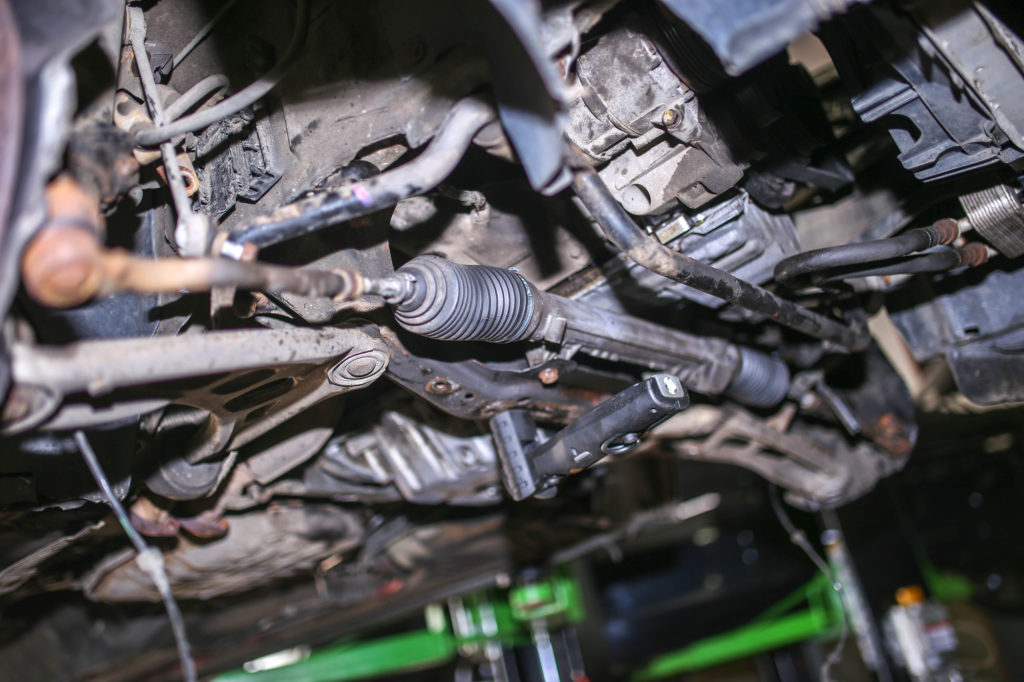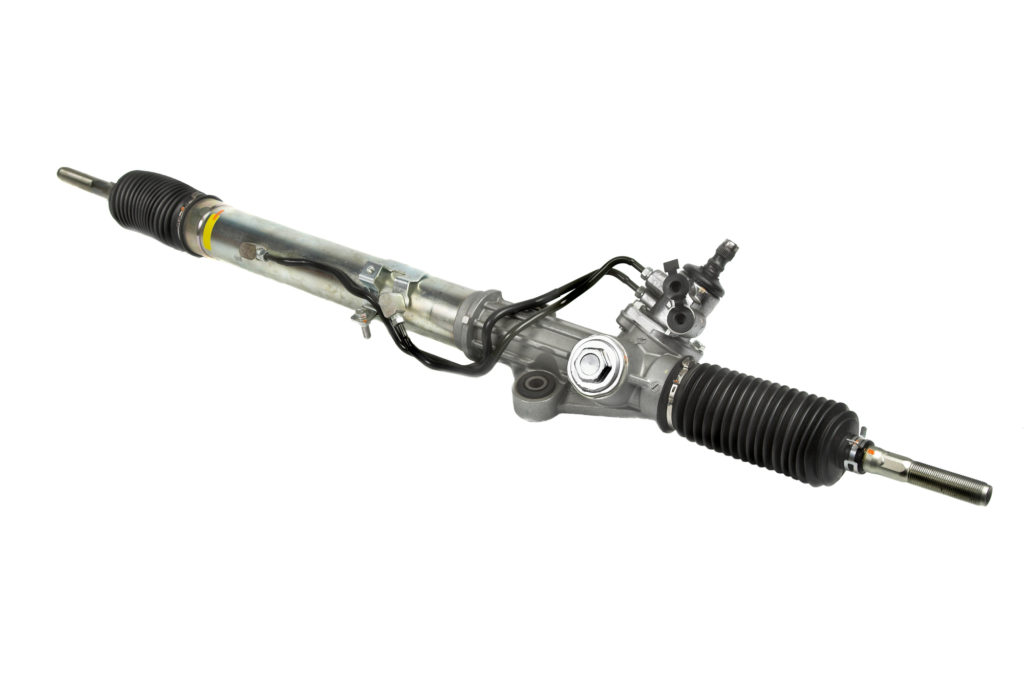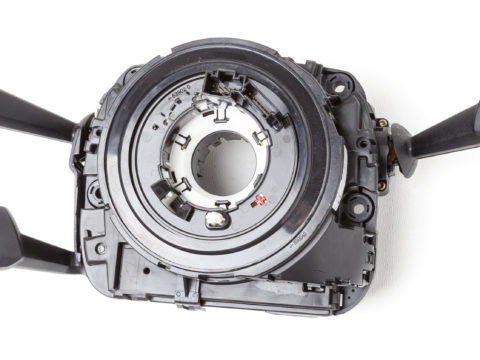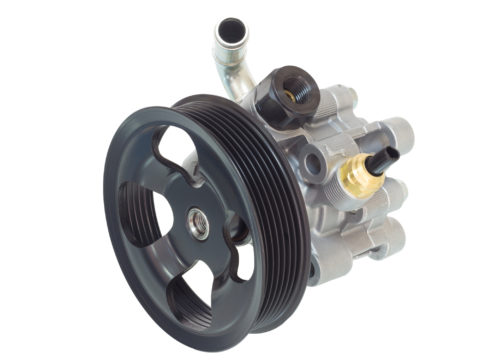A rack and pinion leak usually doesn’t happen because of something simple. A split hose or a burned-out spark plug is easy to fix, but rack and pinion problems are more complicated to find and repair.
Read on to learn what a rack and pinion system does, how to detect a leak, and how much it’ll cost to get it repaired.

Contents
How Does a Rack and Pinion System Work?
Rack and pinion systems are linear actuators because they turn circular motion into linear motion. Any machine that uses a wheel for movement or lifts items, such as heavy industrial machinery, typically uses some form of rack and pinion device.
The rack part of the rack and pinion system is a bar with deep grooves. The bar sits inside a metal tube parallel to the front axle. The pinion part of this system is a gear inside the steering column.
The gear spins when the driver turns the steering wheel. Its teeth pull the rack by its grooves in that direction to move the car wheels.
The way the rack engages the car wheels differs depending on which type of rack and pinion system is in the vehicle.
- End take-off systems attach an axial rod at each end of the rack to each tie rod end.
- Center take-off systems attach tie rods with bolts to the center of the rack.
Power steering fluid is a hydraulic fluid used inside the system to lubricate the moving parts and prevent wear and corrosion. The fluid also creates a hydraulic link between the steering wheel and car wheels to make it easier to turn them.
What Are the Signs of a Bad Rack and Pinion?
You’ll notice a rack and pinion system developing problems through a few different signs.
1) Tight or Shaky Steering
A steering wheel that’s hard to turn at slow speeds is one of the most common signs of rack and pinion leaks. Without the fluid and pressure inside the system, you lose the leverage the system provides and feel more of the weight of turning the car wheels.
At highway speeds, the steering can feel loose and unpredictable. Sometimes the steering wheel rattles and shakes.
2) Off-Center Steering Wheel
If your steering wheel stops returning to the center, as usual, it could indicate a leak or other problem with the steering system.
3) Fluid Puddles Beneath the Vehicle
If your car is parked and leaves a pink or reddish puddle on the ground when you pull away, it’s probably leaking power steering fluid. The steering wheel will get more difficult to turn as the fluid level drops.
Some brands of power steering fluid might be amber or clear. Any puddle beneath your car should be investigated, not just for rack and pinion problems but radiator leaks, oil leaks, and other leaks that can hinder your vehicle’s performance and cause damage.
4) Sounds and Smells
You might notice a creaking or grinding sound when you turn the wheels, particularly while turning after a stop. An oily smell or a scent like burning oil can also indicate that your rack and pinion system is starting to fail.
5) Unevenly Worn Tires
Though many vehicle problems can cause uneven wear on your tires, rack and pinion issues regularly cause tires to wear more on either the inside or the outside.
How to Test Rack and Pinion
You can test your rack and pinion system at home by driving the car’s front wheels onto a pair of ramps so someone can check underneath it for rack movement.
Slowly turn the steering wheel until they say the rack moves. If you’ve turned it more than half an inch, there’s too much play in the steering, indicating a likely problem.
An easy way to judge this distance is to make a mark or attach a piece of tape to the wheel as an indicator. Hold your other finger next to it, unmoving, while you slowly turn the wheel. The gap between your finger and the indicator at the point the rack moves should be no more than half an inch.
You should check whether the power steering fluid is leaking while the car is elevated, too. You can also grasp the steering column and try to move it. If you can, you probably need repair or replacement.
The best way to thoroughly test your rack and pinion system is to take the car to a mechanic.
Causes of Rack and Pinion Leaks
A few common culprits cause most rack and pinion leaks.
- Regular wear and tear damage the system over time.
- Lack of maintenance like fluid changes and flushes cause dirty, thick power steering fluid. When the fluid can’t flow properly, it can cause a leak or other damage.
- Damaged seals or gaskets inside the steering rack prevent proper fluid pressure.
- If the power steering pump fails, it can damage the system.
- Loose connections allow power steering fluid to leak from the system.
Regular maintenance can help prevent dirty, sluggish, or clogged power steering fluid problems and alert you to torn seals or heavy wear before problems start.

How to Fix Rack and Pinion Leaks
Most auto parts stores carry power steering leak sealers. While these sealers might stop the leak temporarily, they’re not meant to last and will leave a residue inside the system that has to be flushed out later.
Some mechanics might suggest rebuilding the system instead of replacing it. Rebuilding services specialize in this type of work. Rebuilding can be a cost-effective option if only some parts of the system need repairs, like a worn rack or other components.
You can find a rack and pinion rebuild diagram and instructions online that explain how to do the job at home. However, it’s recommended that you contact a qualified mechanic unless you have the needed equipment (such as a shop press) and extensive knowledge of rebuilding cars.
Most garages offer power steering services to inspect and flush rack and pinion systems and diagnose the best course of action for your car.
Rack and Pinion Repair Costs
Rack and pinion repair is a time-consuming process. The system is impossible to access without disassembling parts of the vehicle to reach it and using specialty tools.
Rack and pinion repair costs range from about $600 to $1500. The total depends on the extent of the problems and how much needs to be repaired or replaced. If you choose a rebuilding service, the cost could be as low as $500 but could stretch to over $1000.
To find a qualified mechanic, look for repair shops specializing in your car’s brand. Specialty garages will have more in-depth knowledge of your vehicle and will have more parts readily available. These shops will always be Automotive Service Excellence (ASE) certified.
If you choose a shop that takes all types of cars, ensure they’re ASE certified. Finally, look at the shop’s reviews online to see if they have a good reputation.
FAQ
The most frequently asked questions include whether it’s safe to drive with a leaking rack and pinion and how long it takes to repair.
Is it safe to drive a car with a leaking rack and pinion?
If you have to drive somewhere, you can, but it’s not safe to continue driving with a leaking rack and pinion system. The power steering will eventually fail, making the vehicle difficult to steer.
How long can I ride with a bad rack and pinion?
A bad rack and pinion system will quickly result in difficulty controlling the steering. It’s not safe to drive with rack and pinion problems because the ability to turn the car without great effort can disappear at any time.
How long does it take to repair rack and pinion leaks?
While each repair job is unique, rack and pinion repairs typically take three to six hours for a qualified mechanic to complete. If you attempt to do the work yourself, unless you have experience with this type of replacement, the job can take twice as long or more.













